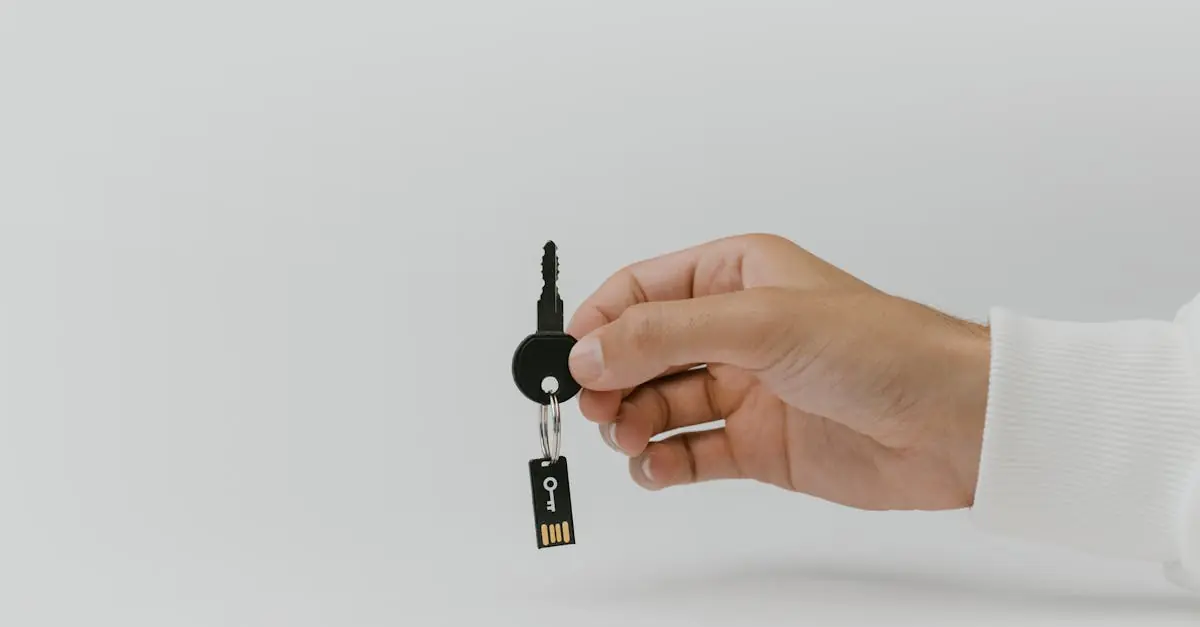Table of Contents
ToggleIn a world where cyber threats lurk around every digital corner, USB security dongles have emerged as the unsung heroes of data protection. These tiny gadgets pack a powerful punch, safeguarding sensitive information with the finesse of a ninja in a tuxedo. Imagine your data as a prized possession; wouldn’t you want a bouncer at the door? That’s exactly what these dongles do—they’re the bouncers of your digital life.
Overview Of USB Security Dongles
USB security dongles serve as vital tools for safeguarding sensitive information. They utilize encryption to protect data during transmission, preventing unauthorized access. Businesses rely on these devices to ensure secure authentication processes for users.
Different types of USB security dongles exist, each offering varying features. Some provide multifactor authentication, requiring more than just a password for access. Others may include biometric capabilities, like fingerprint recognition, enhancing security layers.
Manufacturers design these dongles to be user-friendly and portable. Plugging one into a USB port grants immediate access to secured systems without complicated setup procedures. The compact size allows for easy transportation, making them suitable for mobile professionals.
Many industries benefit from integrating USB security dongles into their security protocols. Financial institutions use them to protect customer data and transaction integrity. Healthcare providers leverage these devices to comply with privacy regulations while securing patient information.
An added benefit includes their effectiveness against phishing attacks. Employing a USB dongle diminishes the risk of stolen passwords, as it requires physical possession of the device. This aspect makes them an essential element in comprehensive cybersecurity strategies.
USB security dongles offer reliable protection for organizations seeking to enhance their data security measures. Their functionality, ease of use, and ability to integrate with existing systems contribute to their widespread adoption.
Types Of USB Security Dongles
USB security dongles come in various types, each designed for specific security needs. Understanding these types helps organizations choose the right solution to protect sensitive data.
Hardware-Based Dongles
Hardware-based dongles are standalone devices that provide physical security. They often store cryptographic keys and require users to insert the dongle into a USB port to access secured systems. These devices enhance security with features like multifactor authentication. For instance, a user must possess the dongle and input a password for access. Many of these dongles include biometric options, allowing fingerprint recognition as an added layer of protection. Businesses in sectors like finance particularly benefit from these hardware solutions, as they ensure that only authorized personnel access sensitive information.
Software-Based Dongles
Software-based dongles focus on offering security through software encryption and licenses. They typically require a USB connection but rely on installed software to validate access. Organizations can use these dongles to validate software licenses, making them essential for compliance and preventing piracy. Users may need to input a password or PIN when using a software-based dongle. Compatibility with various systems plays a crucial role, as these dongles can work across different operating systems and applications. Companies often prefer them for flexibility, as they can be updated remotely and adapted to changing security requirements.
Benefits Of Using USB Security Dongles
USB security dongles deliver critical advantages in protecting sensitive data. They significantly enhance overall cybersecurity for individuals and organizations.
Enhanced Security
Enhanced security arises from the unique features of USB security dongles. Hardware-based dongles store cryptographic keys, making unauthorized access challenging. They require physical presence for authentication, effectively reducing risks from phishing attacks. Multifactor authentication options further strengthen security protocols. A biometric feature allows verification through fingerprints, adding another layer of protection. Organizations in high-risk sectors leverage these capabilities to secure sensitive data and comply with industry regulations. Cyber threats continually evolve, making the robust protection offered by these devices essential for safeguarding digital assets.
User Convenience
User convenience is a vital benefit of USB security dongles. Plug-and-play functionality allows instant access without complicated setups. Professionals on the go appreciate their portability, enabling secure access to systems from any location. Organizations find that integrating these dongles into existing security measures is straightforward. Compatibility with various systems enhances flexibility, allowing easy adaptation to changing requirements. Users experience seamless authentication while maintaining high levels of security. The straightforward user experience leads to increased productivity, as employees can focus on their tasks rather than navigating complex security protocols.
Considerations When Choosing USB Security Dongles
When selecting USB security dongles, several factors play crucial roles in ensuring optimal device performance and security.
Compatibility
Compatibility with existing hardware and software ecosystems is essential. Devices must integrate smoothly into various operating systems like Windows, macOS, and Linux. Organizations often prefer dongles that support multiple platforms to accommodate diverse user environments. Each organization’s specific needs can guide compatibility requirements. Reviewing user feedback and technical specifications helps align choices with intended usage. Compatibility ensures that employees can utilize the dongles without encountering limitations or additional setup challenges.
Cost
Cost considerations significantly influence the choice of USB security dongles. Prices may range from $20 for basic models to several hundred dollars for advanced, feature-rich devices. Investing in more expensive options often yields improved security features and durability. Organizations should factor in the total cost of ownership, including potential maintenance and support expenses. Budget constraints can guide organizations toward effective yet economical solutions. Ultimately, evaluating the balance between initial outlay and long-term benefits is key to making informed decisions.
Conclusion
USB security dongles are essential tools for safeguarding sensitive data in today’s digital landscape. Their ability to provide robust protection against unauthorized access and phishing attacks makes them invaluable for businesses across various sectors. With features like multifactor authentication and biometric verification, these devices enhance security while ensuring a seamless user experience.
As organizations navigate the complexities of cybersecurity, the right USB security dongle can significantly bolster their defenses. By considering factors like compatibility and cost, businesses can make informed choices that align with their security needs. Ultimately, investing in USB security dongles not only protects data but also fosters a more secure working environment.




